Risk-Averse Scheduling of Combined Heat and Power-Based Microgrids in Presence of Uncertain Distributed Energy Resources
Abstract
:1. Introduction
1.1. Background and Motivation
1.2. Literature Review
1.3. Contributions
- A risk-averse (RA) robust scheduling model is proposed for the CHP-based microgrids in the presence of uncertain renewable energy sources.
- The severe uncertainties in the power outputs renewable energy sources are handled via the IGDT technique, without the need for any extra information regarding these uncertainties, such as their corresponding PDFs. In most of the aforementioned literature, the impacts of uncertainties are neglected or considered with scenario-based approaches, which need exact information regarding the uncertain parameters, such as their PDFs.
- The impact of flexibilities such as heat and electricity storages as well as DRP on the optimal and robust scheduling CHP-based microgrid is investigated.
1.4. Paper Organization
2. Problem Modeling
2.1. IGDT
2.2. Probabilistic Modeling of Renewable Energy Resources
2.2.1. Modeling of Solar Radiation
2.2.2. Ambient Temperature Modeling
2.2.3. Wind Speed Modeling
2.3. Demand Response Program (DRP) Modeling
2.4. Objective Function (OF)
2.5. Constraints of Generation and Storage Units
2.5.1. CHP Units
2.5.2. Constraints of Conventional Power Generation, Boilers, and Fuel Cell Units
2.5.3. Wind Power Constraints
2.5.4. Solar Power Constraints
2.5.5. Electrical Energy Storage Constraints
2.5.6. Heat Storage Constraints
2.6. Power Balance
2.7. Implementation of IGDT Method
3. Simulations and Results
3.1. Structure of the Studied Microgrid
3.2. Considered Case Studies
- Case 1: CHP-based microgrid scheduling in islanding (off-grid) mode in the absence of DRP.
- Case 2: Microgrid scheduling in the on-grid mode, without considering DRP capability.
- Case 3: Microgrid scheduling in the on-grid mode, considering DRP capability.
- Case 4: Microgrid scheduling in the on-grid mode, considering DRP capability via the RA strategy of the IGDT technique.
3.3. Simulation Results
3.3.1. Case 1
3.3.2. Case 2
3.3.3. Case 3
3.3.4. Case 4
3.3.5. Monte Carlo Simulations (MCS)
4. Conclusions
- For a given level of β, i.e., β = 0.4 the uncertainty radius, i.e., α is obtained to be 0.34. This means that, with the consent of the 40% reduction in the objective function relative to its base-case value, at least 66% of the predicted amount of power generation by renewable energy sources could be available.
- By considering random variations of uncertain parameters based on their corresponding PDFs, via MCS trials, it is observed that the obtained schedule for the microgrid is robust for the determined radius of uncertainty.
- The robust schedule of the microgrid is obtained without any information regarding the nature and behavior of uncertain parameters, e.g., their PDF.
- Additionally, despite the other methods for uncertainty handling, such as MCS and scenario-based stochastic modeling, the IGDT does not add any computational complexity to the scheduling problem of microgrids.
Author Contributions
Funding
Data Availability Statement
Conflicts of Interest
Nomenclature
| Alphabetic symbols | |
| a, b, c, d, e, f | CHP unit cost function coefficients |
| A | Area of solar farm ) |
| B | Heat stored in the storage unit |
| C | Cost of the unit’s operation |
| c | Scale parameter of Weibull PDF |
| DL | Percentage of decreasing demand |
| E | Battery stored power |
| H | Heat generated (MW) |
| IL | Percentage of increasing demand |
| k | Form parameter of Weibull PDF |
| P | Power generation and demand |
| s | Solar radiation |
| SU | Startup status of the units |
| SD | Shut down status of the units |
| T | Ambient Temperature (°C) |
| V | Binary variable indicator of ON and OFF status of the units |
| Greek symbols | |
| Maximum possible deviation of the uncertain parameter | |
| Degree of tolerance of the reduction of the OF | |
| Parameters of the beta function | |
| Uncertain input parameter | |
| Cost function coefficient of a fuel cell | |
| Price of electricity market | |
| Mean | |
| Cost function coefficient of a boiler | |
| Standard deviation | |
| Wind speed | |
| Set of decision-making variables | |
| Set of uncertainties | |
| Gamma function | |
| Critical value of objective function | |
| Uncertainty radius of the uncertain parameter | |
| Cost function coefficient of a conventional power generation unit | |
| Subscripts | |
| cha | Battery charging |
| discha | Battery discharging |
| gain | Heat return |
| loss | Energy losses |
| h | Total number of power generation units |
| i | Number of CHP units |
| j | Number of conventional power generation units |
| k | Number of boiler units |
| l | Number of fuel cell units |
| m | Number of wind turbines |
| t | Time (Hour) |
| Superscript | |
| CHP | CHP unit |
| CI, CO, R | Minimum, maximum, rated wind speed |
| inc | Transferred demand from the other hours to t |
| dec | Transferred demand from t to the other hours |
| WT | Wind turbine |
| 0 | Microgrid demand before applying the DRP |
| B | Fuel cell unit |
| F | Boiler unit |
| P | Conventional power generation unit |
| T | Temperature |
| s | Solar radiation |
References
- Yaprakdal, F.; Yılmaz, M.B.; Baysal, M.; Anvari-Moghaddam, A. A Deep Neural Network-Assisted Approach to Enhance Short-Term Optimal Operational Scheduling of a Microgrid. Sustainability 2020, 12, 1653. [Google Scholar] [CrossRef]
- Ramli, M.A.M.; Bouchekara, H.R.E.H.; Alghamdi, A.S. Efficient Energy Management in a Microgrid with Intermittent Renewable Energy and Storage Sources. Sustainability 2019, 11, 3839. [Google Scholar] [CrossRef] [Green Version]
- Wang, Y.; Huang, Y.; Wang, Y.; Li, F.; Zhang, Y.; Tian, C. Operation Optimization in a Smart Micro-Grid in the Presence of Distributed Generation and Demand Response. Sustainability 2018, 10, 847. [Google Scholar] [CrossRef] [Green Version]
- Dagdougui, Y.; Ouammi, A.; Benchrifa, R. Energy Management-Based Predictive Controller for a Smart Building Powered by Renewable Energy. Sustainability 2020, 12, 4264. [Google Scholar] [CrossRef]
- Wang, J.; Wu, C.; Niu, T. A Novel System for Wind Speed Forecasting Based on Multi-Objective Optimization and Echo State Network. Sustainability 2019, 11, 526. [Google Scholar] [CrossRef] [Green Version]
- Alipour, M.; Mohammadi-Ivatloo, B.; Zare, K. Stochastic scheduling of renewable and CHP-based microgrids. IEEE Trans. Ind. Inform. 2015, 11, 1049–1058. [Google Scholar] [CrossRef]
- Bui, V.-H.; Hussain, A.; Kim, H.-M. A multiagent-based hierarchical energy management strategy for multi-microgrids considering adjustable power and demand response. IEEE Trans. Smart Grid 2018, 9, 1323–1333. [Google Scholar] [CrossRef]
- Tang, J.; Ding, M.; Lu, S.; Li, S.; Huang, J.; Gu, W. Operational flexibility constrained intraday rolling dispatch strategy for CHP microgrid. IEEE Access 2019, 7, 96639–96649. [Google Scholar] [CrossRef]
- Chaouachi, A.; Kamel, R.M.; Andoulsi, R.; Nagasaka, K. Multi objective intelligent energy management for a microgrid. IEEE Trans. Ind. Electron. 2013, 60, 1688–1699. [Google Scholar] [CrossRef]
- Mohammadi, S.; Soleymani, S.; Mozafari, B. Scenario-based stochastic operation management of microgrid including wind, photovoltaic, micro-turbine, fuel cell and energy storage devices. Int. J. Electr. Power Energy Syst. 2014, 54, 525–535. [Google Scholar] [CrossRef]
- Aluisio, B.; Dicorato, M.; Forte, G.; Trovato, M. An optimization procedure for Microgrid day-ahead operation in the presence of CHP facilities. Sustain. Energy Grids Netw. 2017, 11, 34–45. [Google Scholar] [CrossRef]
- Kopanos, G.M.; Georgiadis, M.C.; Pistikopoulos, E.N. Energy production planning of a network of micro combined heat and power generators. Appl. Energy 2013, 102, 1522–1534. [Google Scholar] [CrossRef]
- Rajabi, F.; Salami, A.; Azimi, M. Hierarchical and multi-level demand response programme considering the flexibility of loads. IET Gener. Transm. Distrib. 2020, 14, 1051–1061. [Google Scholar] [CrossRef]
- Gholizadeh, A.; Rabiee, A.; Fadaeinedjad, R. A scenario-based voltage stability constrained planning model for integration of large-scale wind farms. Int. J. Electr. Power Energy Syst. 2019, 105, 564–580. [Google Scholar] [CrossRef]
- Li, C.; Jia, X.; Zhou, Y.; Li, X. A microgrids energy management model based on multi-agent system using adaptive weight and chaotic search particle swarm optimization considering demand response. J. Clean. Prod. 2020, 262, 121247. [Google Scholar] [CrossRef]
- Li, H.; Wan, Z.; He, H. Real-Time Residential Demand Response. IEEE Trans. Smart Grid 2020, 11, 4144–4154. [Google Scholar] [CrossRef]
- Wang, Z.; Paranjape, R.; Chen, Z.; Zeng, K. Layered stochastic approach for residential demand response based on real-time pricing and incentive mechanism. IET Gener. Transm. Distrib. 2020, 14, 423–431. [Google Scholar] [CrossRef]
- Kazemi, M.; Mohammadi-Ivatloo, B.; Ehsan, M. Risk-based bidding of large electric utilities using information gap decision theory considering demand response. Electr. Power Syst. Res. 2014, 114, 86–92. [Google Scholar] [CrossRef]
- Ilbahar, E.; Cebi, S.; Kahraman, C. A state-of-the-art review on multi-attribute renewable energy decision making. Energy Strat. Rev. 2019, 25, 18–33. [Google Scholar] [CrossRef]
- Soroudi, A.; Ehsan, M. IGDT based robust decision making tool for DNOs in load procurement under severe uncertainty. IEEE Trans. Smart Grid 2013, 4, 886–895. [Google Scholar] [CrossRef] [Green Version]
- Soroudi, A.; Rabiee, A.; Keane, A. Information gap decision theory approach to deal with wind power uncertainty in unit commitment. Electr. Power Syst. Res. 2017, 145, 137–148. [Google Scholar] [CrossRef] [Green Version]
- Wu, Y.; Chu, H.; Xu, C. Risk assessment of wind-photovoltaic-hydrogen storage projects using an improved fuzzy synthetic evaluation approach based on cloud model: A case study in China. J. Energy Storage 2021, 38, 102580. [Google Scholar] [CrossRef]
- Nojavan, S.; Mohammadi-Ivatloo, B.; Zare, K. Optimal bidding strategy of electricity retailers using robust optimisation approach considering time-of-use rate demand response programs under market price uncertainties. IET Gener. Transm. Distrib. 2015, 9, 328–338. [Google Scholar] [CrossRef]
- Abapour, S.; Mohammadi-Ivatloo, B.; Hagh, M.T. Robust bidding strategy for demand response aggregators in electricity market based on game theory. J. Clean. Prod. 2020, 243, 118393. [Google Scholar] [CrossRef]
- Zare, K.; Moghaddam, M.P.; El Eslami, M.K.S. Demand bidding construction for a large consumer through a hybrid IGDT-probability methodology. Energy 2010, 35, 2999–3007. [Google Scholar] [CrossRef]
- Majidi, M.; Mohammadi-Ivatloo, B.; Soroudi, A. Application of information gap decision theory in practical energy problems: A comprehensive review. Appl. Energy 2019, 249, 157–165. [Google Scholar] [CrossRef] [Green Version]
- Moradi-Dalvand, M.; Nazari-Heris, M.; Mohammadi-Ivatloo, B.; Galavani, S.; Rabiee, A. A Two-Stage Mathematical Programming Approach for the Solution of Combined Heat and Power Economic Dispatch. IEEE Syst. J. 2019, 14, 2873–2881. [Google Scholar] [CrossRef]
- Geem, Z.W.; Cho, Y.H. Handling non-convex heat-power feasible region in combined heat and power economic dispatch. Int. J. Electr. Power Energy Syst. 2012, 34, 171–173. [Google Scholar] [CrossRef]
- Kelly, J.J.; Leahy, P.G. Sizing battery energy storage systems: Using multi-objective optimisation to overcome the investment scale problem of annual worth. IEEE Trans. Sustain. Energy 2019, 11, 2305–2314. [Google Scholar] [CrossRef]
- Gladysz, B.; Kluczek, A. A framework for strategic assessment of far-reaching technologies: A case study of Combined Heat and Power technology. J. Clean. Prod. 2017, 167, 242–252. [Google Scholar] [CrossRef]
- Orfanos, G.A.; Georgilakis, P.S.; Hatziargyriou, N.D. Transmission expansion planning of systems with increasing wind power integration. IEEE Trans. Power Syst. 2013, 28, 1355–1362. [Google Scholar] [CrossRef]
- Kayal, P.; Chanda, C.K. Optimal mix of solar and wind distributed generations considering performance improvement of electrical distribution network. Renew. Energy 2015, 75, 173–186. [Google Scholar] [CrossRef]
- Independent Electricity System Operator (IESO). Ieso.ca. [Online]. 2015. Available online: https://www.ieso.ca/ (accessed on 19 June 2021).
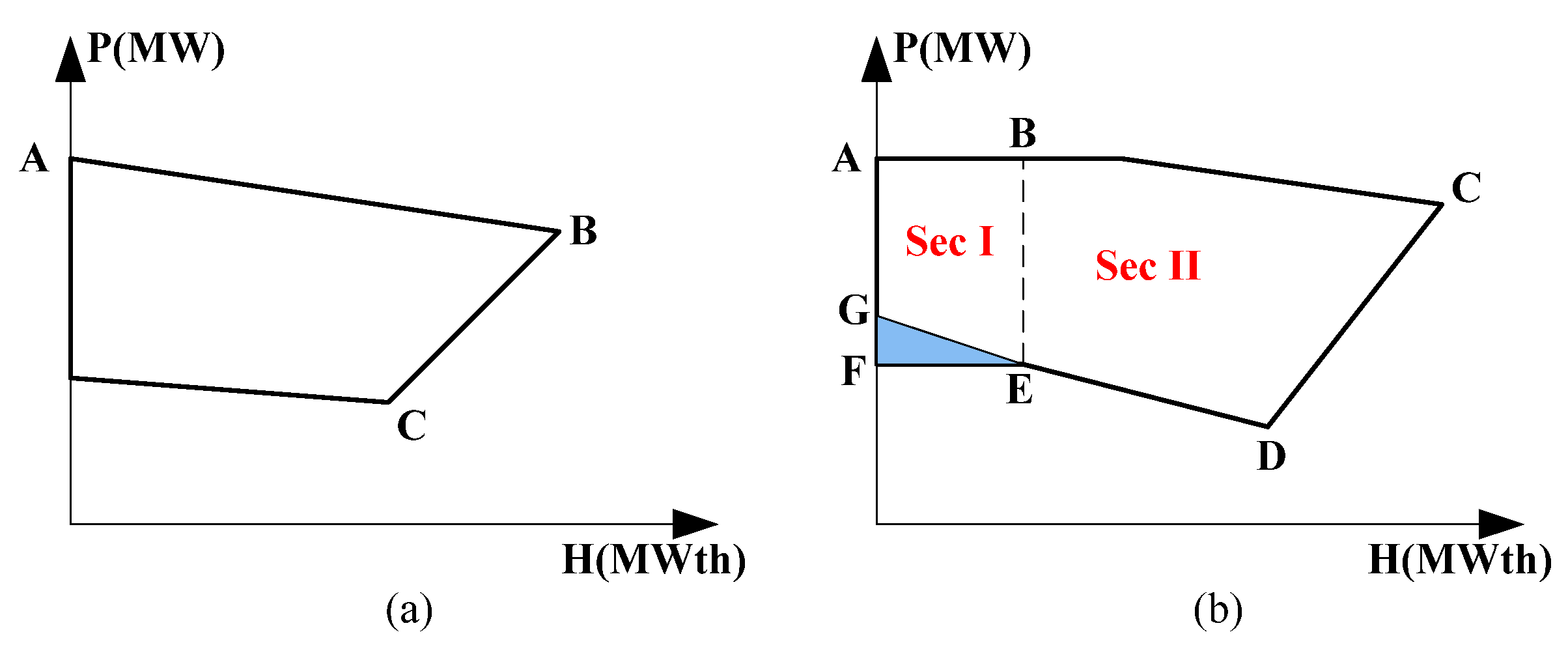
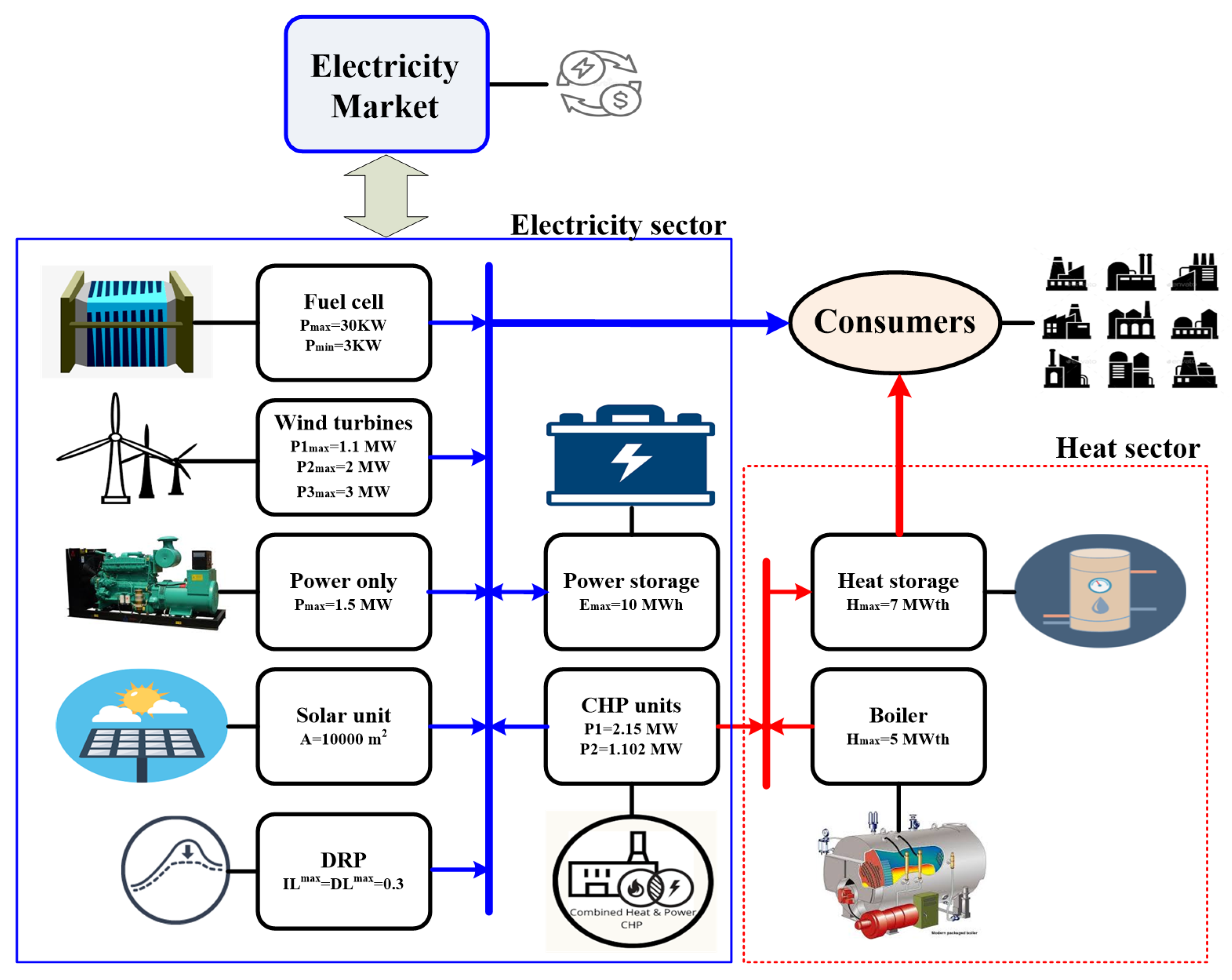


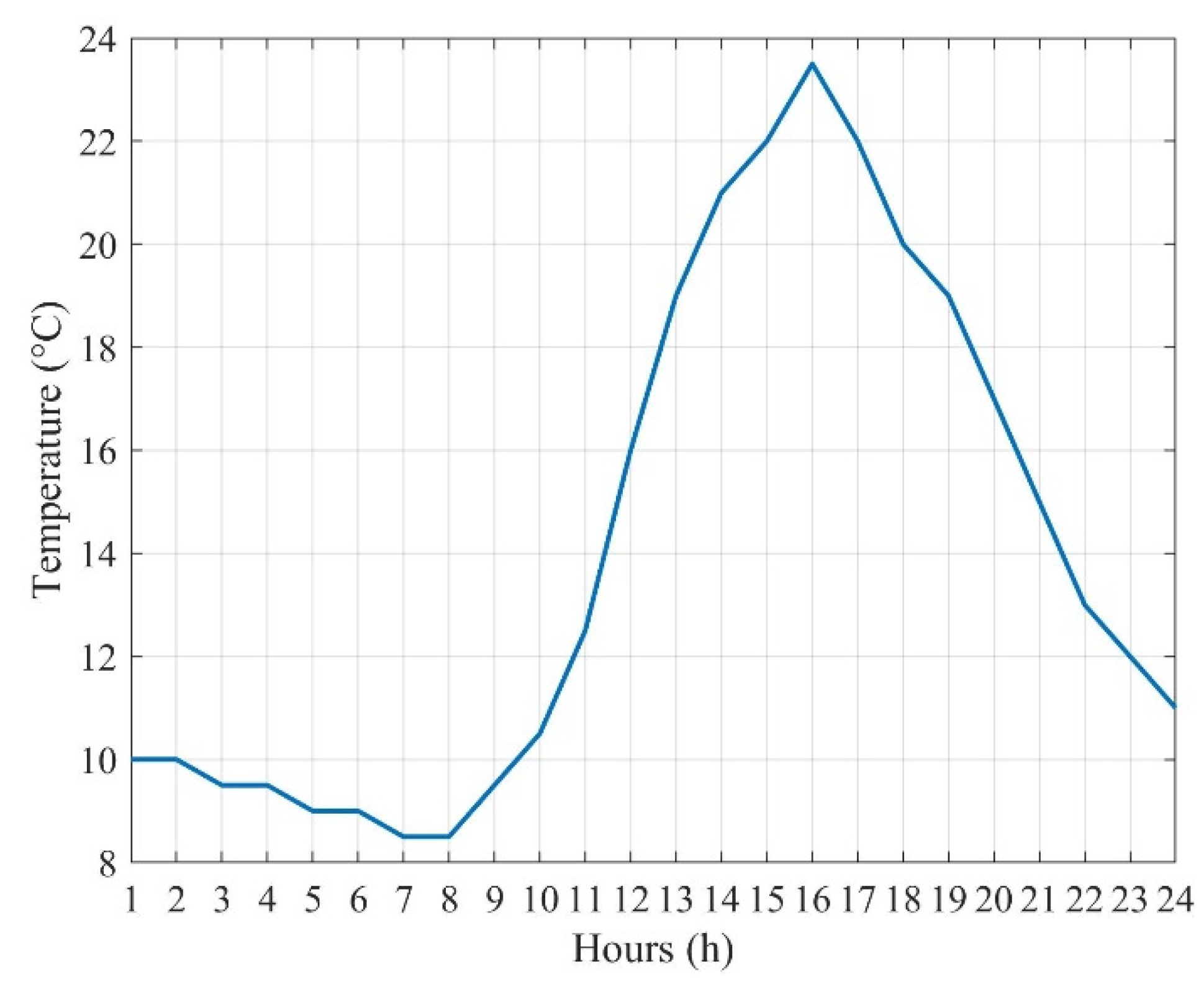
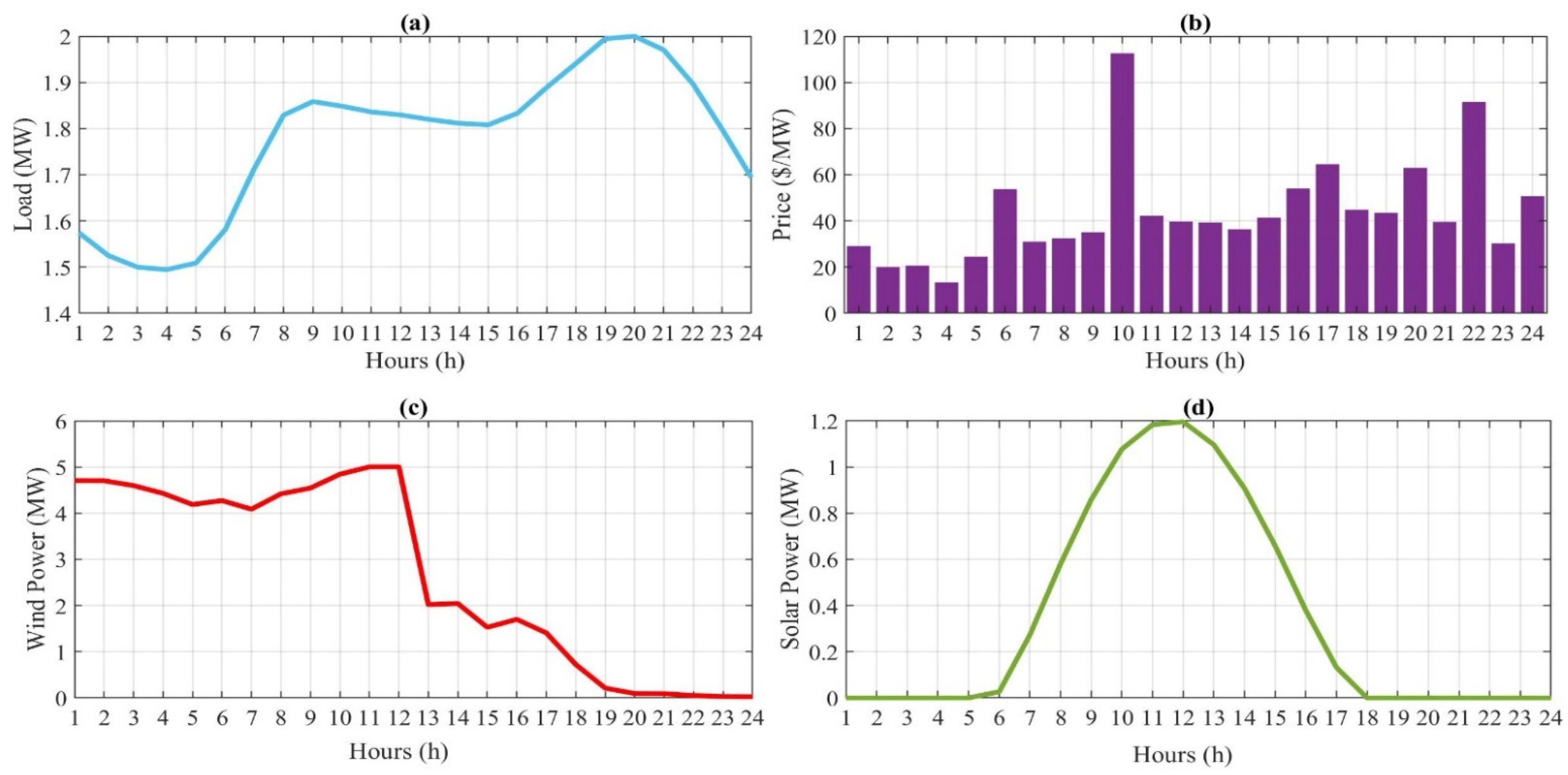
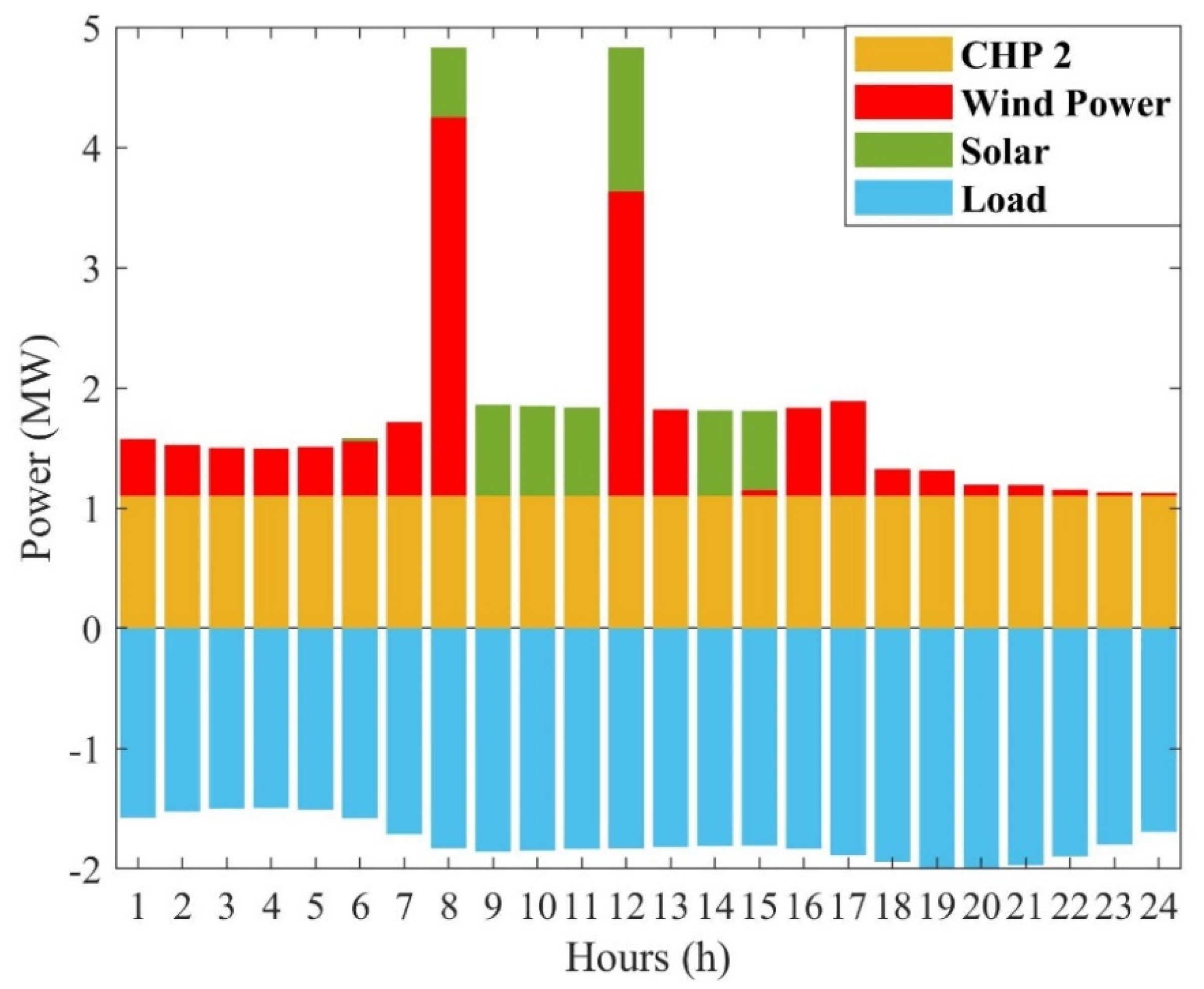
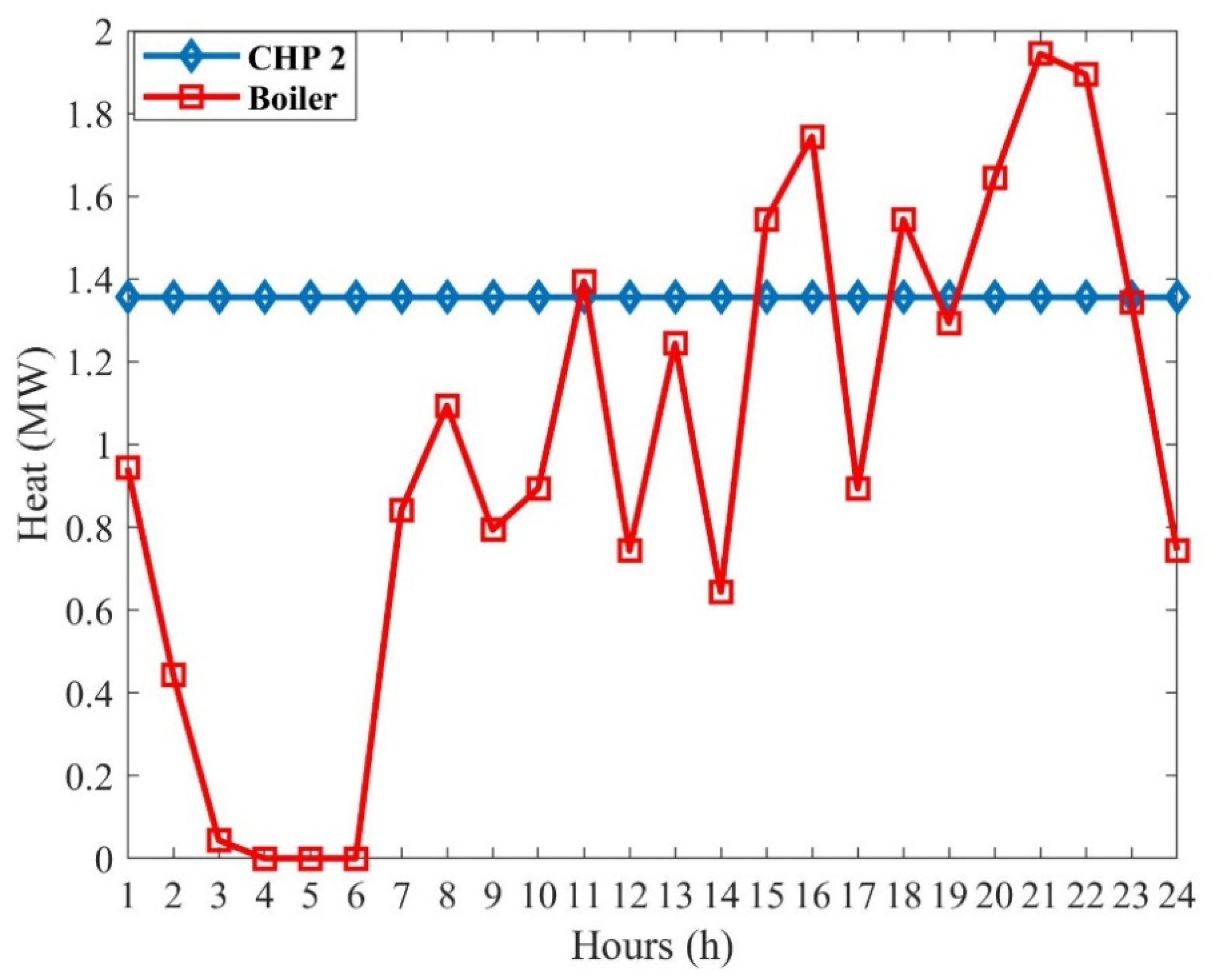

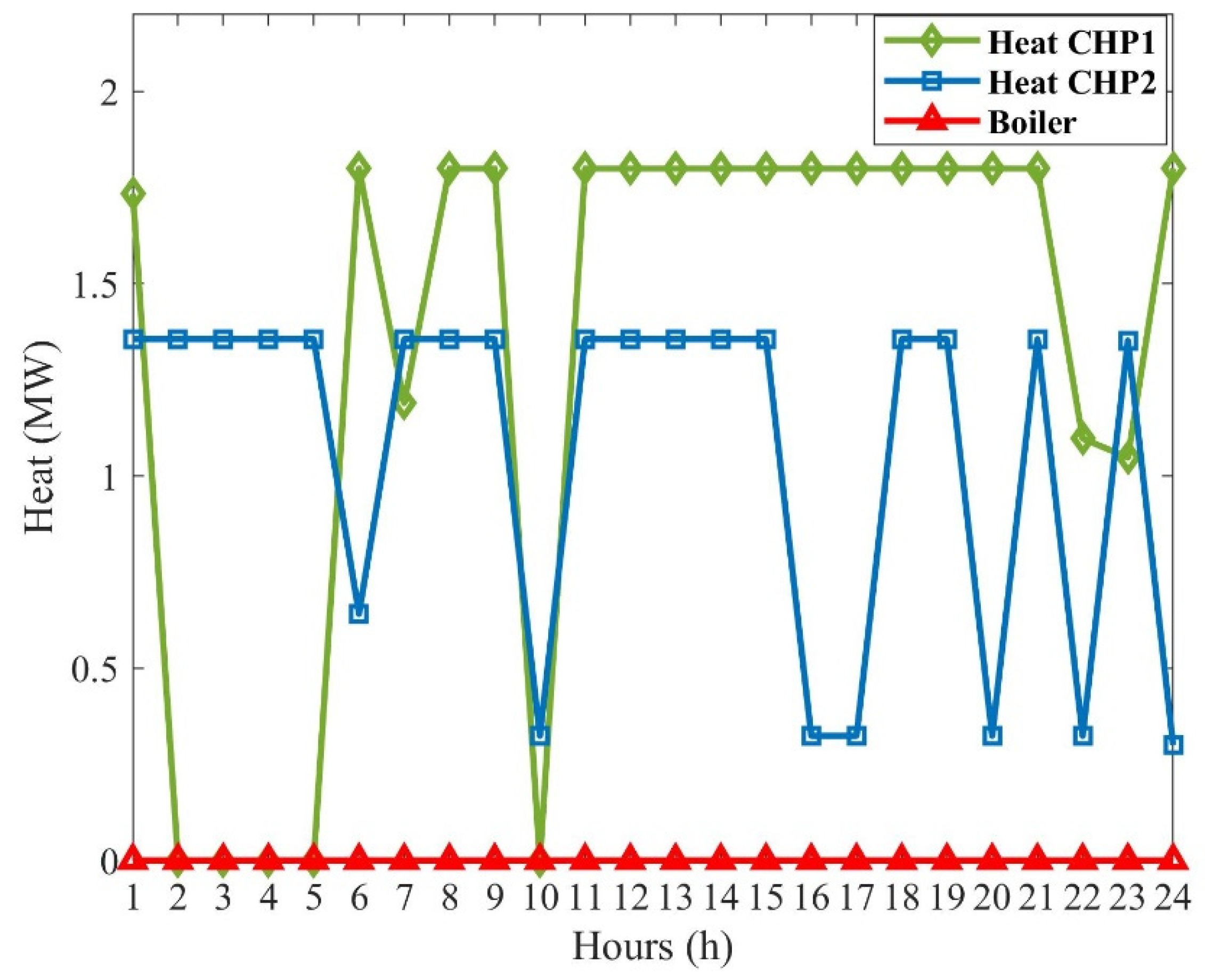
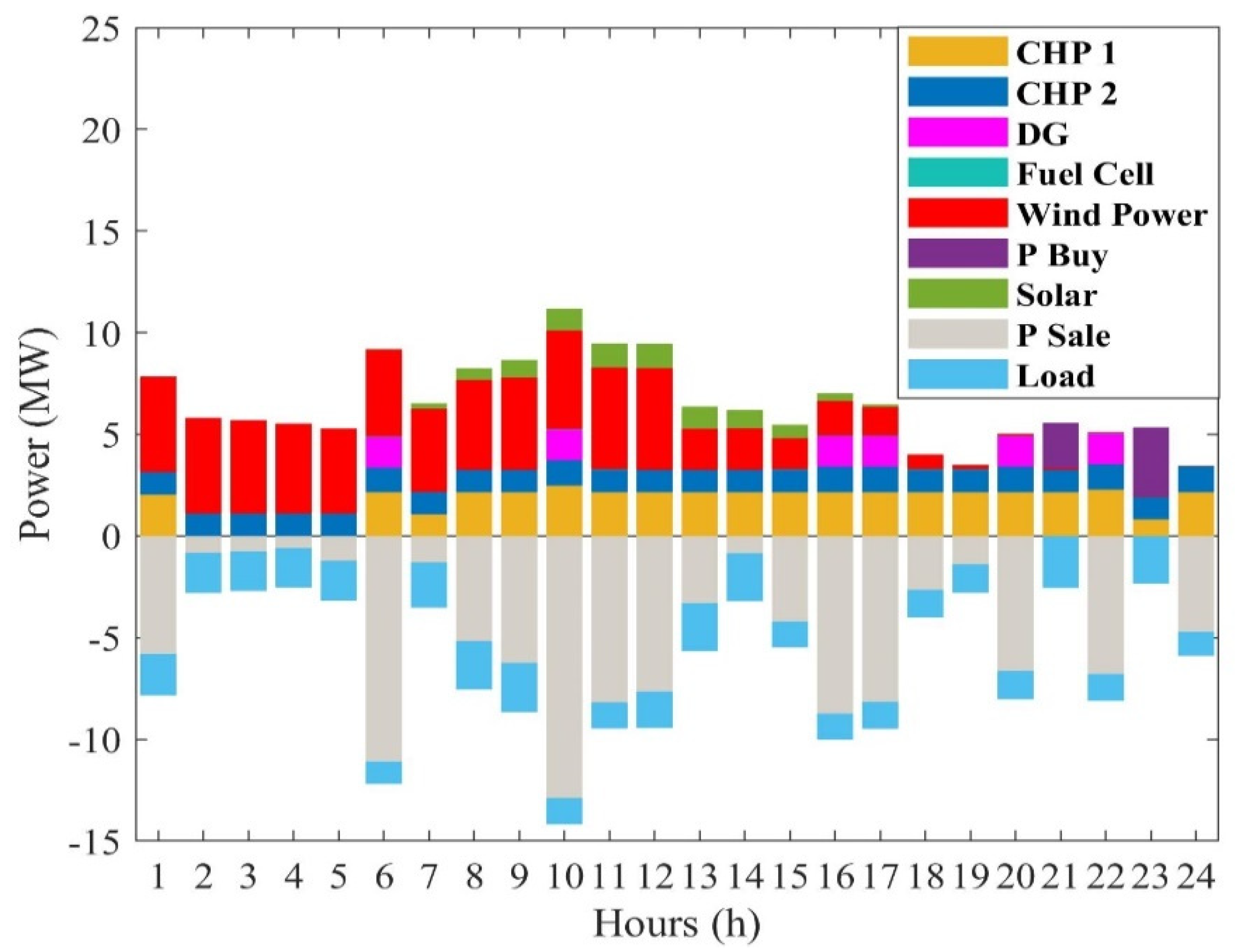
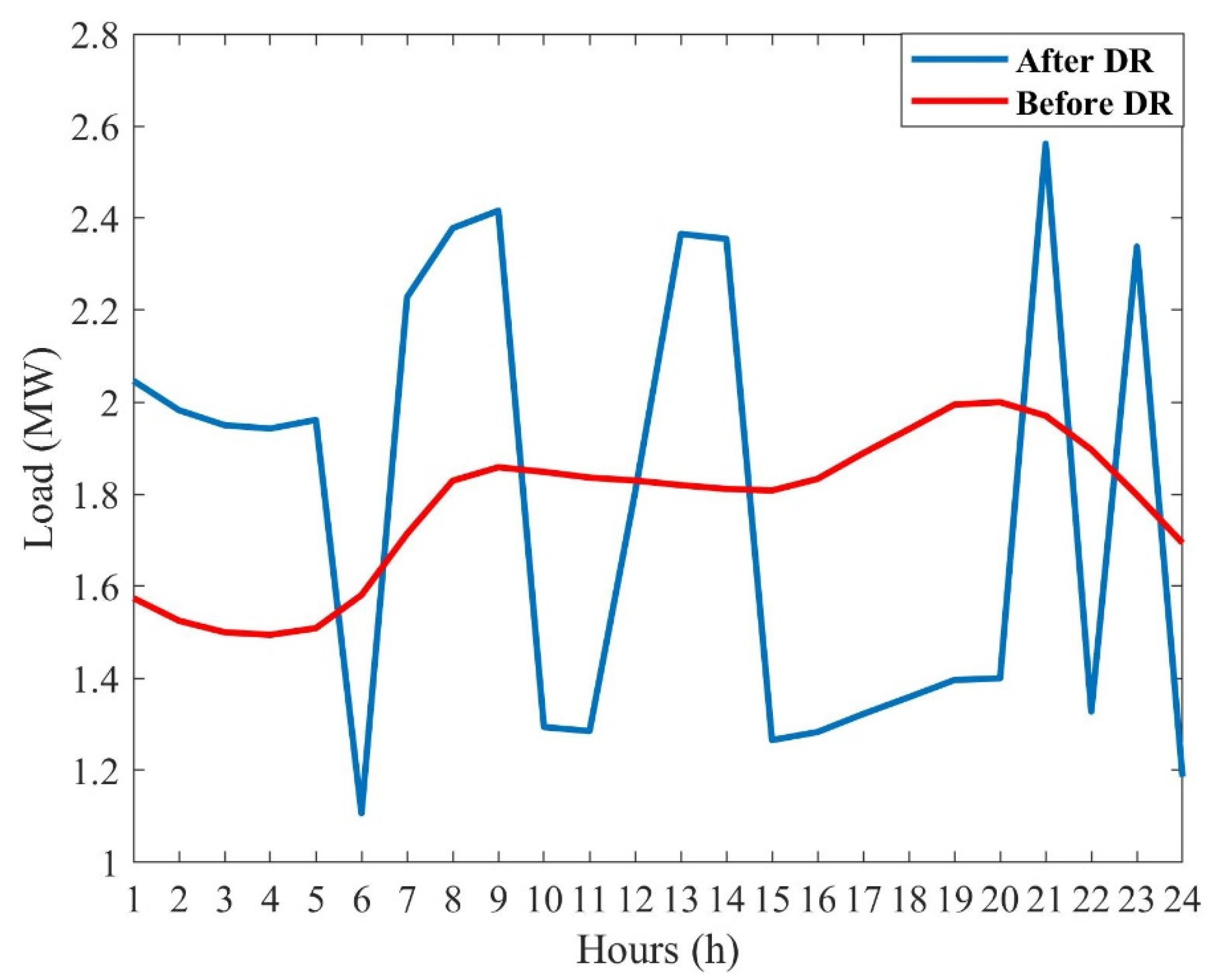

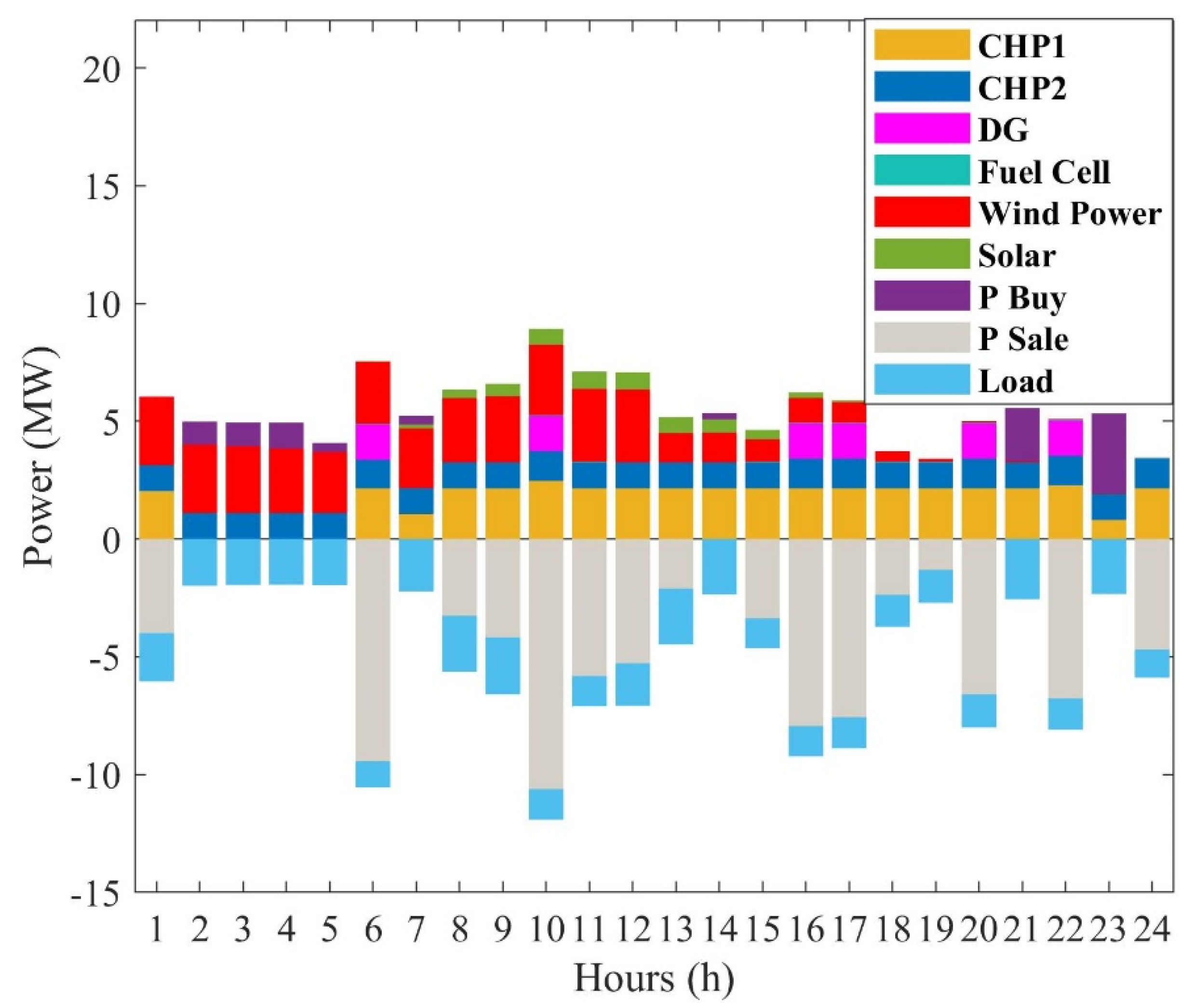

| Specification | Value | Specification | Value |
|---|---|---|---|
| Pcha.max (MW) | 3 | Emax (MW) | 6 |
| Pcha,min (MW) | 0 | Emin (MW) | 0 |
| Pdisch,max (MW) | 3 | ηcha | 0.9 |
| Pdisch,min (MW) | 0 | ηdisch | 0.9 |
| bgain | bloss | η | (MW th) | (MW th) | Bmax (MW th) | Bmin (MW th) |
|---|---|---|---|---|---|---|
| 0.3 | 0.6 | 0.01 | 2 | 2 | 7 | 0 |
| Unit/Specification | Startup Cost (USD) | Shut Down (USD) |
|---|---|---|
| CHP1 | 20 | 20 |
| CHP2 | 20 | 20 |
| Power-Only | 12 | 12 |
| Heat-Only | 9 | 9 |
| Fuel Cell | 0.0207 | 0.0207 |
| Hours (h) | µv | σv | Hours (h) | µv | σv |
|---|---|---|---|---|---|
| 1 | 10.7 | 3.0363 | 13 | 6.2667 | 0.6807 |
| 2 | 10.5667 | 2.7647 | 14 | 6.3333 | 0.7506 |
| 3 | 10.3667 | 2.9501 | 15 | 5.6000 | 0.3606 |
| 4 | 9.9333 | 3.1005 | 16 | 5.8333 | 0.6506 |
| 5 | 9.6000 | 3.0512 | 17 | 5.3667 | 1.2014 |
| 6 | 9.6667 | 3.0892 | 18 | 4.0667 | 1.7559 |
| 7 | 9.6333 | 3.2347 | 19 | 2.8667 | 1.3013 |
| 8 | 10.0333 | 2.9143 | 20 | 2.7333 | 1.0017 |
| 9 | 10.1667 | 2.4826 | 21 | 2.8000 | 0.8888 |
| 10 | 10.5333 | 2.3459 | 22 | 2.8000 | 0.7937 |
| 11 | 11.0000 | 2.5515 | 23 | 2.8333 | 0.6351 |
| 12 | 11.2333 | 2.5891 | 24 | 2.9000 | 0.6083 |
| Hours (h) | µs | σs | Hours (h) | µs | σs |
|---|---|---|---|---|---|
| 1 | 0 | 0 | 13 | 0.6780 | 0.1283 |
| 2 | 0 | 0 | 14 | 0.5699 | 0.1011 |
| 3 | 0 | 0 | 15 | 0.4124 | 0.0765 |
| 4 | 0 | 0 | 16 | 0.2394 | 0.0446 |
| 5 | 0 | 0 | 17 | 0.0834 | 0.0230 |
| 6 | 0.0158 | 0.0196 | 18 | 0 | 0 |
| 7 | 0.1605 | 0.0334 | 19 | 0 | 0 |
| 8 | 0.3412 | 0.0658 | 20 | 0 | 0 |
| 9 | 0.506 | 0.1002 | 21 | 0 | 0 |
| 10 | 0.6385 | 0.1319 | 22 | 0 | 0 |
| 11 | 0.7120 | 0.1551 | 23 | 0 | 0 |
| 12 | 0.7305 | 0.1510 | 24 | 0 | 0 |
| Case # | Objective Function (USD) | Generation Cost (USD) | Sale Revenue (USD) | Purchase Cost (USD) | α | β |
|---|---|---|---|---|---|---|
| 1 | −2013.5 | 2013.50 | - | - | - | |
| 2 | 2371.01 | 3405.97 | 5928.10 | 150.84 | - | - |
| 3 | 2556.49 | 3405.97 | 6153.02 | 190.56 | - | - |
| 4 | 1533.90 | 3405.97 | 5195.38 | 255.52 | 0.34 | 0.40 |
Publisher’s Note: MDPI stays neutral with regard to jurisdictional claims in published maps and institutional affiliations. |
© 2021 by the authors. Licensee MDPI, Basel, Switzerland. This article is an open access article distributed under the terms and conditions of the Creative Commons Attribution (CC BY) license (https://creativecommons.org/licenses/by/4.0/).
Share and Cite
Rabiee, A.; Abdali, A.; Mohseni-Bonab, S.M.; Hazrati, M. Risk-Averse Scheduling of Combined Heat and Power-Based Microgrids in Presence of Uncertain Distributed Energy Resources. Sustainability 2021, 13, 7119. https://doi.org/10.3390/su13137119
Rabiee A, Abdali A, Mohseni-Bonab SM, Hazrati M. Risk-Averse Scheduling of Combined Heat and Power-Based Microgrids in Presence of Uncertain Distributed Energy Resources. Sustainability. 2021; 13(13):7119. https://doi.org/10.3390/su13137119
Chicago/Turabian StyleRabiee, Abbas, Ali Abdali, Seyed Masoud Mohseni-Bonab, and Mohsen Hazrati. 2021. "Risk-Averse Scheduling of Combined Heat and Power-Based Microgrids in Presence of Uncertain Distributed Energy Resources" Sustainability 13, no. 13: 7119. https://doi.org/10.3390/su13137119








